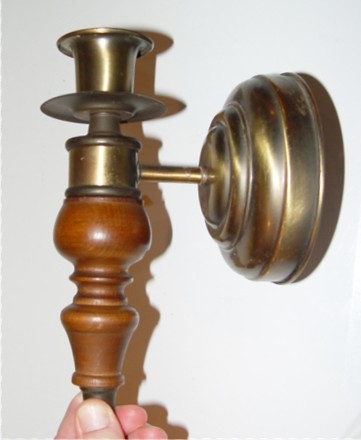Today, Julie worked on the steps out front.
She had gone to a tile store, and bought some nice tile from their clearance room. She broke them into pieces, and added some sea glass, shells, and broken pottery from rejected pots. She layed out patterns of shards to attach to the risers of the stairs.
When she worked at deciding what shards would go where, I worked on my rayguns. I used a box cutter and a small drill in my cordless screwdriver to carve out the groove that the trigger guards would go into in each raygun. I carefully used the boxcutter to cut the surface of the wood, and then used the drill to go deep. Between the box cutter and a metal pick from my tool box, I created two fairly clean groves. I also drilled a hole for the trigger. I started small, and worked my way up through the bits until the hole was big enough.
I brought the trigger guards out into the garage, wrapped the edges in cloth, and then clamped them into my bench vise (the cloth is to keep the vise from scratching the surface of the metal). I used a hacksaw to cut the trigger guards to the right length to fit into the grooves, arch over the trigger, and then touch the orthogonal metal stem on the ray gun. The orthogonal stem will be surrounded by the handle when the raygun is complete.
I tore long strips of aluminum foil to wrap around the wood of the guns, to shield them from the heat of my torch when I soldered. I used three layers, with air gaps between. I needed to solder the trigger guards while they were in place because the angle between the trigger guard, wood body of the raygun, and orthogonal stem of the raygun needed to form a tight triangle, and I had doubts about my ability to torch the guards on free hand.
Here is a picture of what one of the wall sconses looked like before I started. I pieced this together this morning, Julie took pictures, and later I realized that I had assembled the piece slightly incorrectly, but it gives an idea of what I started with:

The correct assembly for the wall sconse would have the flared pan for candle drips moved down to just above the dark ring above the orthogonal stem.
From the side, it looks a bit like a phaser pistol from the original Star Trek series, but with a Victorian flair.
Here is a picture of what the rayguns look like now:

Second half of the afternoon, I helped Julie hand mix eighty pounds of morter. She worked outside, mudding the shards and applying them to the steps. On the tops of the steps, she mortered decorative pavers.
It dirty work. Each piece needs to be 'buttered' on the back with morter, then applied to the surface of the wall. Morter is pushed between the pieces, and then a heavy wet sponge is used to smooth the morter and clean the face of the shards.
The decorative pavers seemed to involve lots of whacks with a rubber mallet, to get the morter to comress underneath so they can be correctly leveled.
She did three steps today. We have two more bags of morter, and the tree biggest steps to do.
I moved buckets of water, fetched drinks, and set up a fan to keep her cool. I also puttered around in the garage, straitening things up on the workbench, and fabricated a base plate for the foot pedal to Julie's flex shaft. Every time she uses it, she gets a shock because the cover on the bottom of the pedal was lost. I cut a piece of masonite to the right shape for the base plate, glued and screwed a small wooden block to it, then added four peg feet. I used a screw to go through the top of the pedal case into my block of wood to hold the new base plate on.





